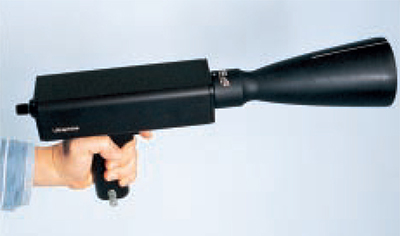Low Level Leaks
Getting "up close and personal" with a leak at a distance demands advanced technology detection equipment. A portable long-range leak detection module was designed at the Kennedy Space Center (KSC) to spot jet-type leaks in the fluid systems of critical, out-of-reach launch and ground support equipment.
The long-range leak detector improvements were born when the entire Space Shuttle fleet was grounded due to leak problems in the main engine compartments. KSC contract engineers devised off-the-shelf ultrasonic leak detectors. While these detectors proved helpful in finding the leaks, they lacked long-range sensitivity, simple operator interface, and ease of use. Further enhancement of the detectors was called for when a set of Space Shuttle solid rocket boosters demanded a leak check once-over.
The KSC-developed leak detector has been refined for commercial purchase. This innovation is being offered under an exclusive licensing agreement between NASA and UE Systems, Inc., Elmsford, New York.
Working like an ultrasonic telescope, the Ultraprobe 2000 hand-held unit incorporates the long-range, NASA-developed module. It incorporates state-of-the-art circuitry, improved transducers, and a unique collecting horn that delivers a higher degree of reliability, sensitivity, and versatility over previously used leak detectors. UE Systems offers the Long Range Leak Detection Module (UE-LRM-2) and the Close Focus Leak Module (UE-CFM-2).
A uniquely shaped receiving chamber resembles the intake port of a jet engine in the UE-CFM-2. The shape enhances the turbulent flow of a pressure or vacuum leak and gives a user the capacity to locate minute leaks that might otherwise go undetected. Some of the most common plant applications are in leak detection in pressure and vacuum systems, such as boiler, heat exchanger, condensers, chillers, distillation columns, vacuum furnaces, and specialty gas systems. The most subtle changes in the integrity of seals and gaskets in tanks and pipe systems can be exposed.
"The new system," says Terrence O'Hanlon, president of UE Systems, "was developed to overcome the limitations of low sensitivity and discrimination against background noises found in most other commercially available instruments."
In the UE Systems' Long Range Leak Detection Module, the unique parabolic design of the sonic collection chamber is shaped to reflect all ultrasonic signals directly to the apex of the instrument's transducer. The signal is then preamplified and transferred to a pistol housing where it is amplified further, then mixed with a signal from a local oscillator that shifts the received ultrasonic signal to an audible frequency. In electronic terms, this process is commonly referred to as hetrodyning or demodulation. The captured, "double amplified" audio signal is then sent to headphones or a spectrum analyzer for further analysis or data storage.
O'Hanlon explains that the UE Systems leak detection device could save American manufacturers money. He points to a Department of Energy study that determined in most factories, there is an opportunity for energy conservation. In some factories, the study found an "outrageous" waste of energy associated with compressed air systems. The study states that detection of one air leak could save a firm thousands of dollars each year. "Leaks equal money," O'Hanlon asserts.
The unit is small, lightweight, and rugged compared to other currently used systems, opening the door to a wide variety of commercial uses. A multifaceted instrument, the detector provides testing capabilities ranging from simple leak detection to sophisticated methods of mechanical analysis. The ultrasonic device is an ideal center piece of predictive and preventive maintenance programs in virtually every industry. Commercial application of the detector hardware includes: pipelines, underground utilities, air-conditioning systems, petrochemical systems, power transmission lines, and in medical devices.

The most subtle of leaks can be discerned with UE Systems' is detection equipment. This hand-held device was born out of NASA's need to detect leaks in out-of-reach Space Shuttle hardware and launch pad equipment.













